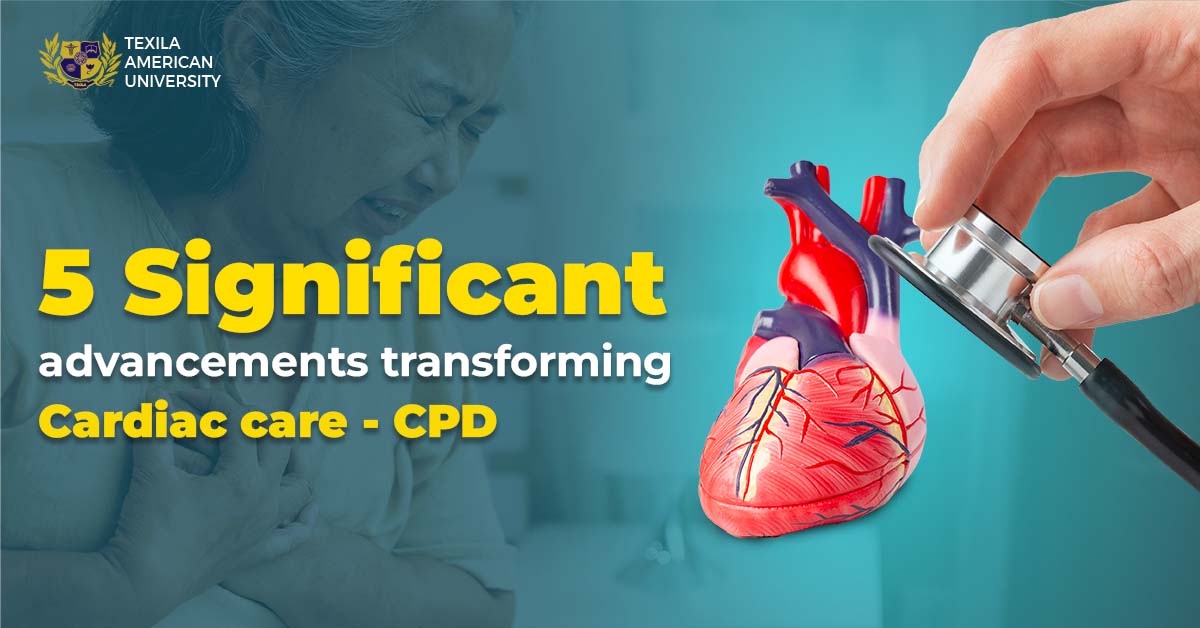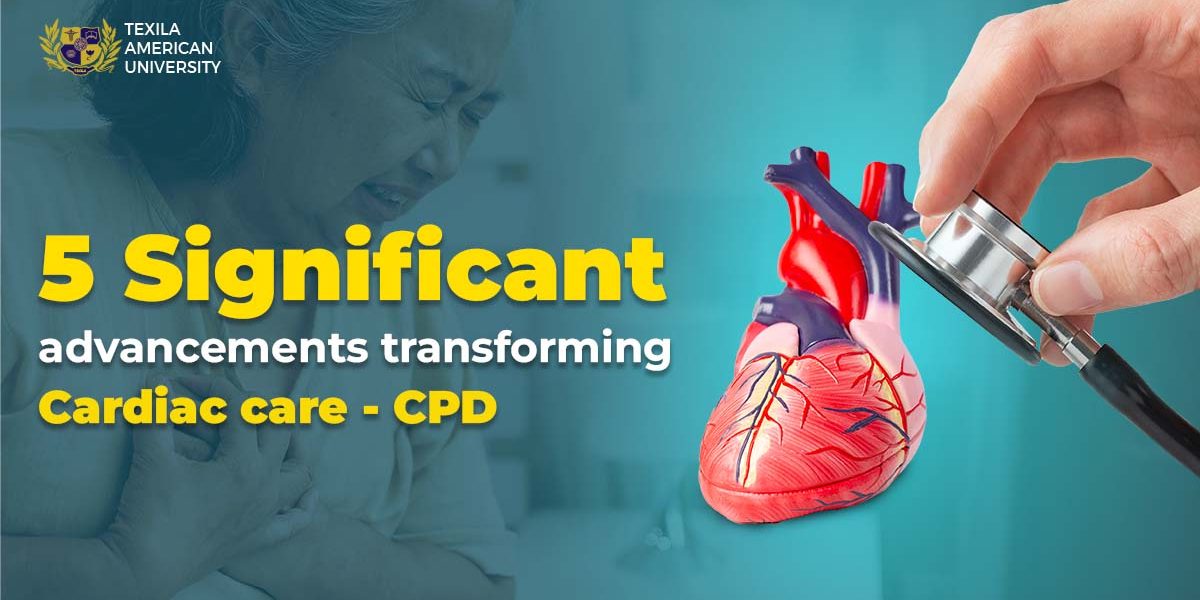Blog Summary:
Cardiologists specialize in the treatment of CVDs. The treatment involves the use of medicines and catheter therapies to treat heart conditions. MBBS graduates and final-year medical students can pursue the Texila CPDs certification program in cardiology to gain knowledge in the fundamentals of cardiology. Lifestyle choices increase the risk of CVDs WHO states that CVDs cause 32% of global deaths. Patient-specific 3D heart models, transdermal patches for stroke victims, implantable heart-rhythm monitors, nanotechnology to treat cholesterol, and AI and machine learning to interpret heart conditions are some of the advancements in the field of cardiology. These technologies are in the initial phases of development and might revolutionize cardiac treatments.
Physicians who specialize in the treatment of Cardiovascular Diseases (CVD) are called cardiologists.
- Use medicines and catheter therapies to treat heart conditions
- They treat hypertension, cholesterol, heart rhythm disorders, chest pain, heart attack, etc.
- Discuss with patients, analyze symptoms, diagnose various heart ailments and prescribe necessary treatments and preventive measures to maintain good health.
Sub-specialties include:
- Clinical cardiac electrophysiology deals with the treatment of heart-rhythm-related complaints.
- Pediatric cardiologists deal with treating heart diseases in children.
- Interventional cardiologists perform non-surgical heart procedures like placement of coronary stents or catheter-based intervention to treat heart conditions.
Medical graduates and final-year medical students who wish to study cardiology can join a certificate in cardiology course. It’s completely online and of six months duration. It enables you to get acquainted with the basics, which will help during your residency period.
Causes of heart failure:
Lifestyle choices like an unhealthy diet, physical inactivity and use of tobacco and alcohol lead to increased blood pressure, blood glucose, blood lipids, overweight and obesity. Which in turn increases the risk of heart disease and stroke. Also, the vital cause of increasing CVDs in many. According to WHO, CVDs cause 32% of global deaths.
What is shocking is the fact that a large percentage of individuals between the age group of 30 – 45 are affected by stroke and ischemic heart disease. Recent analysis reports suggest that the COVID-19 virus also initiates heart ailments. With the increasing incidence of heart diseases, medical and research professionals worldwide are working to improve the well-being of people by creating awareness; prevent and manage CVDs with the help of associated medical technologies.
Artificial Intelligence and Machine learning has brought significant advancements in cardiac therapies. It enables you to detect symptoms at the early stages and provide necessary treatment with improved results. Let’s look at some of the advancements in therapies still in the initial phase of development that might revolutionize cardiac treatments.
1) Patient-specific 3D heart models:
3D printing has progressed in the last decade, used in orthopedics, tumors and cardiovascular disease therapies. Patient-specific or personalized 3D printed heart models are developed from MRI scans, which enables patients and families to understand heart conditions and complex anatomy. Simulations facilitate surgeons decide on the best treatments. Plan and perform surgeries with ease and improved outcomes. It’s an effective training tool to educate medical professionals and students about surgical procedures.
2) Transdermal patch for stroke victims:
Do you know? A skin patch can help improve the chances of survival in stroke victims. The patch delivers the glyceryl trinitrate drug, which widens blood vessels and lower blood pressure. It minimizes the potential damage caused by stroke. Early treatment is vital in stroke care since 85% of the damage occurs within the first two hours following an attack. The skin patch applied to patients immediately after a suspected stroke attack aids in speedy recovery. Once the patch passes the required safety tests and receives the necessary endorsements, it might transform stroke care. It can be one of the first aid measures by paramedics in ambulances.
3) Implantable heart-rhythm monitors:
Irregularity in heart rhythm is common in patients with heart conditions. ECGs help monitor the heart rhythm of patients for a particular moment. Whereas implantable loop recorders or heart rhythm monitors record data over a period of time, it helps determine causes for fainting, palpitations, slow or fast heartbeat, and irregular heart rhythm that can lead to stroke. It’s a tiny device implanted under the chest skin. It works similar to an ECG picking up electrical signals from the heart.
4) Nanotechnology to treat cholesterol:
Atherosclerosis or narrowed blood vessels is one of the common causes of CVDs and can lead to death in humans. Cholesterol or fat deposits in blood vessels restricts blood flow and oxygen. Hence it’s vital to regulate and balance cholesterol levels. Studies suggest Statins have helped lower cholesterol levels and reduced the risk of heart diseases by 42%. But statins have potential side effects on muscle and liver, making people intolerant to the drug.
Scientists are developing nanomaterials that deliver cholesterol-lowering medicines directly to the areas with fat deposits. They are extremely small with high stability and biodegrade on depositing the drugs at specific fat deposit areas.
5) Artificial intelligence (AI) and Machine Learning (ML) to interpret heart conditions:
With widespread applications, scientists are working on integrating AI and advanced computing with clinical practice and diagnostics to improve treatment outcomes and provide better care.
Machines quickly analyze large data volumes, which helps in making effective decisions, accurate diagnoses and planning treatment procedures by detecting specific patterns in patient data. AI-based systems are used in cardiovascular imaging and predicting risks. For example, using computers to analyze CT scans and diagnose stroke saves valuable time. Integrating AI to ECGs can help detect abnormalities in heart rhythms; provide treatment at early stages to prevent heart failure.
Benefits of pursuing online certificate in cardiology course:
MBBS or MBChB graduates and final-year medical students are eligible to pursue the certification program from Texila CPD. It’s a short-term program for six months. It’s a fundamental program designed for doctors who wish to pursue cardiology. The courses are completely online and can fit into your busy schedules.
- Enhances your understanding of cardiovascular physiology and associated disorders
- Gain knowledge in basic mechanisms, clinical manifestations, diagnostic strategies, and management of coronary artery disease
- Learn to analyze and diagnose cardiovascular disorders
- Evaluate heart disease in patients, perform primary treatment and refer them to CVD specialists on time.
The professional certification program in cardiology at Texila CPD is the best certificate course in cardiology. The curriculum is designed to equip you with the fundamentals:
- ECG-basics
- Various types of ECGs and their relation to cardiac disorders
- Exposure to coronary artery disease. Analyzing the cause, symptoms, development, diagnosis, and management of various heart conditions and chest pain
Highlights of Certificate in Cardiology CPD course:
- Online learning with flexible schedules to study at your convenience.
- Get trained on various procedures via interactive live webinars with faculty members
- MCQ assessments with a certificate of completion.
Key Takeaways:
Choice of lifestyle affects the overall health of individuals across the globe. Avoiding tobacco and alcohol, reducing salt intake, eating more fruits and vegetables and physical fitness reduce the risk of CVDs. Effective health policies that facilitate people to make affordable healthy choices; motivate them to adopt and sustain a healthy lifestyle are the need of the hour.
Identifying high-risk individuals and providing appropriate treatment at the early stages help prevent premature deaths. Access to medicines, health technologies and qualified professionals to provide necessary treatment and counseling at all primary health care facilities is essential in cardiac care.
Texila CPD offers the best certificate course in cardiology. Enhance your knowledge to:
- Determine and diagnose cardiac diseases in adults using ECG and other tests
- Assess heart disease in patients, perform primary treatment and refer them to CVD specialists on time.


